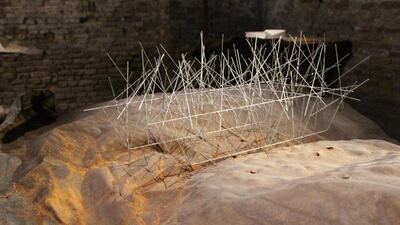Next up in our series of reports from the 15th International Architecture Exhibition of the Venice Biennale is Anum Laghari, an architectural engineer who graduated from the United Arab Emirates University in Al Ain and is currently working as a research assistant. She is passionate about sustainable architecture and is currently applying for LEED certification. She is one of a team of interns manning the UAE National Pavilion and, during her free time in the city, she visited Chile’s Pavilion. Here she tells us about it:
Against the Tide, the Chilean Pavilion at the Venice Biennale, aims to bring forward the conjoined efforts of a newer and younger generation of architects all belonging to the Central Valley of Chile, Collectively, they toil towards the betterment of the people residing in the rural parts of Chile. The project primarily focuses on the social aspects of architecture that reflect the ambition of giving back to the people.
Curated by Juan Roman and Jose Luis Uribe, Against the Tide signifies the opposition to the natural flow of things in the political world of architecture where personal gain dominates over collective benefit. It explores an alternative course that things can take. In that sense, the spectacularly designed exhibition responds to the overall theme of the 2016 exhibition, Reporting from the Front, which illustrates to us that at the heart of things, architecture is fundamentally about people and the ways in which the quality of the built environment can affect their daily lives.
The exhibition presents 15 projects conceived, designed and constructed by young architects. It showcases small scale models of the real structures erected in Chile. The architects’ work is a true reflection of the dedication, commitment and enthusiasm they showed by their return to their hometown in order to contribute to their community after completing their academic training. In this rural milieu and landscape a sequence of viewing points, lunch shelters, rest stops, plazas, open pavilions, removable structures and places for shade and social gatherings to benefit the people were carved out. It puts the focus on the traditions, customs and landscapes of the rural domain where physical nature comes to play; they used sustainable local materials and resources to construct their architectural designs.
As you enter the exhibition, you find yourself in a softly lit space surrounded by rusty shades, which helps you to feel familiar with the landscapes of rural Chile. You get a sensory image of what a rural area may look like which complements the experience. You encounter a simple table with Chile’s local materials and resources formed into impressive silhouettes on display. In the main expanse, four distinct pieces fill the vast space: a screen that projects the story, a display area that showcases models of the basic framework of the projects, a large wooden seating structure that allows people to observe and rest, and a flying wall made out of thousands of plastic bags that move along to the wind and depict a symbolic projection of a tide.
In a successful exhibition, issues regarding the community and their surroundings are exposed very delicately in fluid rhythm by a strong visual manifestation. The Chilean Pavilion is a great example of work that depicts a hopeful future where the people and their surroundings are welded together in joyous harmony and the architecture is flexible to the needs of its people.
* Find out more about Anum on Instagram on @anumlaghari. Follow the Venice interns on @veniceinterns and hashtags #uaeinvenice and #veniceinterns

